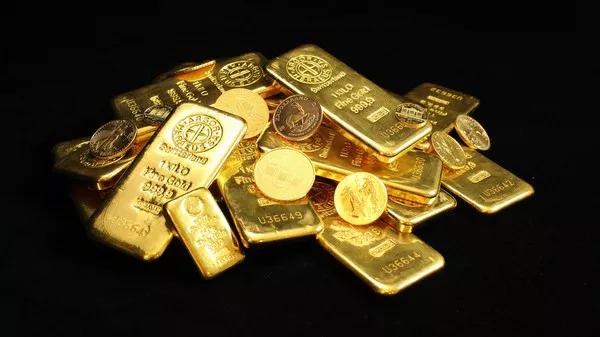Gold futures prices are a key indicator for investors, traders, and anyone interested in the precious metals market. As a commodity that holds both historical significance and contemporary economic value, gold is closely monitored for its price movements. In this comprehensive guide, we explore the dynamics of gold futures prices, the factors influencing them, and the tools available for tracking the latest quotes and charts in this ever-evolving market.
1. Understanding Gold Futures Prices
1.1 What Are Gold Futures?
Gold futures are standardized contracts that allow traders to buy or sell a specified amount of gold at a predetermined future date and price. These contracts are actively traded on commodity exchanges, providing a platform for price discovery and risk management.
1.2 How Are Gold Futures Prices Determined?
Several factors influence gold futures prices, including supply and demand dynamics, geopolitical events, inflation rates, interest rates, and market sentiment. The interplay of these variables contributes to the daily fluctuations in gold futures prices.
2. Tools for Tracking Gold Futures Prices
2.1 Online Financial Platforms
Numerous online financial platforms offer real-time information on gold futures prices. Websites dedicated to financial news and analysis, as well as brokerage platforms, provide users with up-to-the-minute data on gold futures quotes and charts.
2.2 Commodity Exchanges
Commodity exchanges, such as the Chicago Mercantile Exchange (CME) and the Intercontinental Exchange (ICE), serve as primary hubs for trading gold futures. These exchanges offer comprehensive data on gold futures prices, including live quotes and historical charts.
2.3 Mobile Apps
Mobile apps developed by financial news outlets, brokerage firms, and market analysis platforms provide convenient access to gold futures prices on smartphones and tablets. These apps often offer customizable features, enabling users to tailor their market monitoring experience.
2.4 Charting Tools
Charting tools, both within trading platforms and standalone applications, allow users to visualize gold futures price movements over different timeframes. These tools often include technical analysis indicators and drawing tools for in-depth market analysis.
3. Latest Gold Futures Quotes and Charts
3.1 Real-Time Quotes
Real-time quotes provide users with the current market price of gold futures. These quotes typically include the bid (buying) and ask (selling) prices, as well as other relevant information such as the contract expiration date.
3.2 Historical Charts
Historical charts display the price movements of gold futures over specified periods. Traders and analysts use these charts to identify trends, patterns, and potential support or resistance levels that may influence future price movements.
3.3 Candlestick Patterns
Candlestick patterns, commonly used in technical analysis, are visual representations of price movements on charts. Traders interpret these patterns to make informed decisions about market direction and potential entry or exit points.
4. Factors Influencing Gold Futures Prices
4.1 Economic Data
Economic indicators, such as GDP growth, employment rates, and inflation, can impact gold futures prices. For instance, periods of economic uncertainty or inflationary pressures may drive investors to seek the safe-haven appeal of gold.
4.2 Geopolitical Events
Geopolitical events, including political instability, conflicts, and trade tensions, can create volatility in financial markets, influencing gold futures prices as investors turn to gold as a hedge against uncertainty.
4.3 Central Bank Policies
Decisions and statements from central banks regarding interest rates and monetary policy have a significant impact on gold futures prices. Lower interest rates, for example, may make gold more attractive as an alternative investment.
FAQs – Frequently Asked Questions
1. How can I interpret candlestick patterns in gold futures charts?
Candlestick patterns represent price movements and can signal potential trend reversals or continuations. Traders analyze the patterns, such as doji, hammer, and engulfing patterns, to make informed decisions about market direction.
2. Are there differences in gold futures prices across different commodity exchanges?
While gold futures prices generally align across major commodity exchanges, slight variations may occur due to factors like exchange-specific rules, trading volumes, and regional demand and supply dynamics.
3. How often do gold futures prices change during a trading day?
Gold futures prices can experience frequent changes during a trading day, influenced by real-time market developments, economic data releases, and geopolitical events. Traders actively monitor these changes to make timely decisions.
4. Can I track gold futures prices for free?
Yes, many financial platforms and websites provide free access to real-time gold futures prices, historical charts, and market analysis. Brokerage platforms also offer these features to their clients as part of their services.
5. What role does market sentiment play in gold futures pricing?
Market sentiment, driven by perceptions of risk, economic conditions, and geopolitical factors, plays a crucial role in gold futures pricing. Positive sentiment may drive demand for gold as a safe-haven asset, influencing prices upward.
In conclusion, tracking gold futures prices is essential for investors and traders looking to navigate the dynamic precious metals market. Utilizing a combination of online platforms, mobile apps, and charting tools, individuals can stay informed about the latest quotes and charts, analyze market trends, and make informed decisions based on the various factors influencing gold futures prices. Always conduct thorough research, stay updated on market developments, and use available tools to enhance your understanding of gold futures dynamics.

